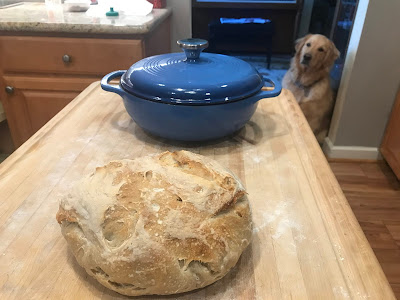The Covid-19 pandemic has brought about some changes in people’s behavior worldwide, and it turned out that at least in this part of the world, other people were changing in ways that seemed eerily familiar to us. One example is my decision in mid-summer to try making sourdough bread. Unknowingly I was joining with hordes of other people who have taken up baking during this long period of social distancing. For a while at least, yeast and certain kinds of flour were unavailable in our supermarket. I had become part of a trend, realizing only later that I was part of a near stampede.
Well over a year ago our daughter Meg’s husband Steve began making sourdough, and we were much impressed with the breads he made, although neither Peg nor I harbored any notions of trying it ourselves. Then about the time that I began trying to make sourdough, our other daughter Pam began also. A good neighbor in Virginia gave her some of her sourdough starter, and so she began. Maybe the news of Pam’s early efforts influenced me or perhaps, each of us may have independently stumbled on this new hobby.
In retrospect, my trying out bread making was a natural; I had gotten interested in fermentation when we began making cheese more than a decade ago while gathering background for The Summer of a Thousand Cheeses. We haven’t tried cheesemaking in a while, but I have regularly made other fermented foods, including sauerkraut, kimchi, and curtido. So why not round out the Random Ferments blog with yet another kind of fermented food product?
I hate being whiny, but the majority of my first five or six tries flopped, producing far less than expected results. The first four resulted in flat, tough hockey pucks, and a fifth was better, but still only slightly resembled a loaf of bread. The first few were made with special bread flour recommended by Steve ($40 for 10 pounds), that despite the pedigree of this ingredient, had no magic. Following other instructions, later attempts used regular all-purpose flour. One recipe even called for use of a packet of store-bought yeast to supplement whatever might be provided by the sourdough starter. It obviously didn’t help, as that attempt was another failure. I should note that we ate these early sourdough products, which were tasty but barely recognizable as loves of bread. The fifth or sixth (sorry, but I’ve lost count), produced under daughter Pam’s tutelage and with some of her starter resulted in an acceptable product which, however differed seriously form the loaf she produced, which was taller, lighter, and definitely more bread-like than mine. A sixth, attempting to follow her successful formulas, produced yet another shrunken, hard, but nevertheless tasty product that was more hardtack than bread.
Success at last! The seventh worked well, and I wish I knew why. My first guess was that, following a suggestion in the first of the several sets of recipes I used filtered water. Could it be that our charcoal filtered water removed some essential substance needed for healthy growth of the yeast? That seems unlikely, and the word from others is that occasional unexplained failures in sourdough breadmaking are to be expected. Nevertheless, six disappointing results in a row seems unusual, especially for me who enjoys experimenting with fermentation, has good equipment, and spent a good many years in chemistry labs.
Two recent successful attempts produced decent loaves of bread, but the dough was too sticky and difficult to handle, some of it was inevitably left behind sticking to cookware, and the loaves were misshaped. In mid-November, following the earlier successful attempts I decided to try again using bread flour. That solved at least partially the problem of too fluid and sticky dough, and the last two loaves have exceeded my modest expectations.
A recent relatively successful loaf of sourdough, attractive to dogs and people alike.
I now think I know why the earlier attempts failed. I believe I did not adequately feed my sourdough starter. Most times of the year our house is warmer than the 68° F. recommended in the recipes I’ve been using. It was 68° this morning when the outdoor temperature had fallen to 47°, but for most of the warmer season our thermostat is set for 79°. That 11° difference could have effectively doubled the rate of metabolism and reproduction of the yeast (anyone with appropriate knowledge could plug the numbers into a formula and calculate the change precisely). So during the warmer months I have likely fed my starter with fresh flour too infrequently, with twice daily feedings perhaps necessary to maintain its activity. So, when it was time to make the dough, the yeast in the starter was mostly depleted and unable to multiply fast enough and metabolize fast enough to produce a rise. Another possibility is that I may have let the first rise of the dough go on too long, again depleting the supply of fresh flour available to produce a healthy crop of yeast.
It has been said that the surest path to true learning is through a series of failures. If that saying is true, I may finally have mastered making sourdough bread. And if my success holds up, it may be time to move on to new challenges, for example trying a sourdough pizza crust.

No comments:
Post a Comment